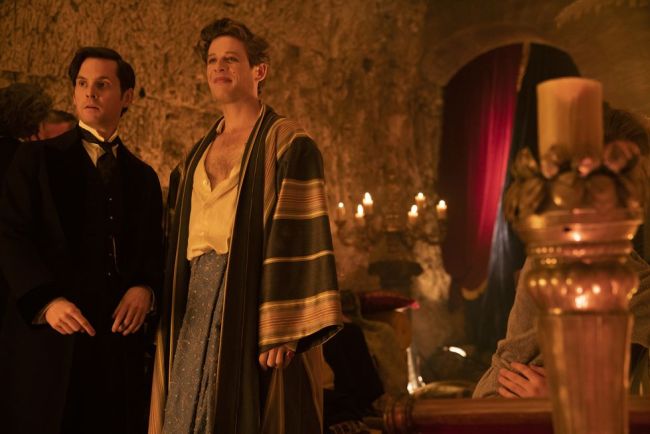
What Secrets Do the Costumes on The Nevers Reveal?
Decoding the hidden messages hidden among the petticoats on the new HBO fantasy series.
How do you dress characters for a period drama when it takes place in a period like none we’ve ever seen before? That was the challenge when it came to The Nevers, the new fantasy series that premiered April 11 on HBO. While the series – about a group of Victorian women blessed (or, perhaps, cursed) with uncanny abilities – takes place in the mid-1890s, it also has to contend with the kind of action (among heroes, villains, and every type in between) that might not always have a true-to-life historical precedent. For costume designer Michele Clapton, a veteran of The Crown and Game of Thrones, that was part of the appeal.
Whether she was dressing Laura Donnelly’s Amalia True, who wears dark colors and stays firmly in the traditions of her time period, or Olivia Williams’s Lavinia Bidlow, a society figure who uses a wheelchair and whose layers might hint at the character’s secrets, Clapton says she was lucky to be able to embrace a recognizable historical moment – but also to be able to tweak it just a bit. “I say [the costumes on the series are] slightly heightened,” she explains. “I think they make you feel secure in the fact that you are actually in this period and it’s not just a fantasy land.”

KEITH BERNSTEIN/HBO
Here, Clapton tells T&C how her costumes help tell the stories – and conceal the secrets – of some of the most unforgettable characters on The Nevers.
What excited you about creating costumes for this series?
It’s funny because I was approached to do it while before -filming began], but unfortunately, I wasn’t available, so I came in on the second episode, which is always strange. I think it worked quite well, though. I suppose I wanted to create each of these very strong women in their ow particular way so that they were identifiable very quickly and would play to their strengths because we get so much of the story just from looking at them.

MICHELE CLAPTON
On top of that, you’re creating costumes that are also period-specific and have to work for action sequences. What’s the creative process like?
As we read scripts, we would work backwards from that and say, “Okay, well maybe she needs culottes here, or a skirt that has buttons so that if she’s underwater, she can put it off quickly.” It actually gets quite tactical, and you sometimes have to think about those things while also still making it look like that costume wasn’t set up for that particular moment. It’s all the stuff that you don’t really think about that actually takes us the longest time.
Were there moments in history that you referenced in the series?
The mid 1890s is where we were. I particularly love the huge sleeves and the silhouettes; in fact, sometimes doing the research you can’t believe that these shapes were really worn because they were so extreme. I think some of the men’s wear and most of the society figures – in particular Lavinia Bidlow, who was one of my favorites to design for – are truer to the period. Whereas with the orphans, we could have fun because their backgrounds were diverse, and we often had to think about how we could disguise whatever their affliction was. I say [the costumes on the series are] slightly heightened. I think they make you feel secure in the fact that you are actually in this period and it’s not just fantasy land.

COURTESY HBO
Was there a character whose look was most difficult to find?
We had a lot of discussions with Amy Manson, who played Maladie, because she is such a chaotic character. It was really important to work with Amy to find out how she was going to play it, because it could easily become over the top. So, it was tempering that performance with what the costume said about her. Yeah. That was a real journey. I also liked doing [James Norton’s] Hugo; there’s something we developed in him, this immense sense of style but with a playfulness. The difficulty was making to all come together to look like a group of people that existed in this time.
Very few of these characters are sharing their true selves to the outside world.
Sometimes with costumes, you want to hint at something a character might become. People might not realize until they’ve watched the series that [some costuming] was a hint about the journey that we were going with them. I love that storytelling.

KEITH BERNSTEIN/HBO
Was there anything that got away?
No, we were pretty lucky and got most things in that we wanted. I’m intrigued to see where some of the characters end up, and, as you’ll see in episodes foie and six, you can’t even imagine where it goes, but it’s going to be exciting when we get there.
Did you create most everything or were you sourcing it?
I would say we made probably 90% of all the principal’s costumes. We had wonderful work rooms and dyes and milliners and everything, and the aging department, which is so key to a lot of that work. We were very fortunate.
I mean, I had great fun with Annie, particularly Rochelle’s character, because we wanted to create something that told us about her past life; there was the idea that she steals and grabs to create her own look. We were trying to build these costumes out of things that would have been around and that show the characters’ lifestyles. I really didn’t want it to be too steam punk, that was something I fought against. We needed to be more clever.
Original article at Town & Country.
This article has been reproduced for archive purposes.